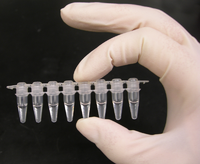
Photo from wikipedia
De novo designed bioactive molecules, such as DNA, RNA and peptides, are utilized in increasingly diverse scientific, industrial and biomedical applications. Concatemerization of designed DNA, RNA and peptides may improve… Click to show full abstract
De novo designed bioactive molecules, such as DNA, RNA and peptides, are utilized in increasingly diverse scientific, industrial and biomedical applications. Concatemerization of designed DNA, RNA and peptides may improve their stability, bioactivity and allow for gradual release of the bioactive molecule at the intended destination. In this context, we developed a new method enabling the formation of DNA concatemers for the production of artificial, repetitive genes, encoding concatemeric RNAs and proteins of any nucleotide and amino-acid sequence. The technology recruits the Type IIS SapI restriction endonuclease (REase) for assembling DNA fragments in an ordered head-to-tail-orientation. Alternatively, other commercially available SapI isoschizomers can be used: LguI and thermostable BspQI. Four series of DNA vectors dedicated to the expression of newly formed, concatemeric open reading frames (ORFs), were designed and constructed to meet the technology needs. • Vector-enzymatic DNA fragment amplification technology. • Construction of DNA concatemers many times longer than those available with the use of current de novo gene synthesis methods. • Biosynthesis of protein tandem repeats with programmable function never seen in nature.
Journal Title: MethodsX
Year Published: 2020
Link to full text (if available)
Share on Social Media: Sign Up to like & get
recommendations!